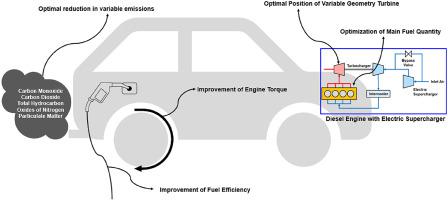Our official English website, www.x-mol.net, welcomes your feedback! (Note: you will need to create a separate account there.)
Fuel Efficiency and Exhaust Characteristics of Turbocharged Diesel Engine equipped with an Electric Supercharger
Energy ( IF 9 ) Pub Date : 2021-01-01 , DOI: 10.1016/j.energy.2020.119049 Seungju Baek , Hyeonjik Lee , Kihyung Lee
Energy ( IF 9 ) Pub Date : 2021-01-01 , DOI: 10.1016/j.energy.2020.119049 Seungju Baek , Hyeonjik Lee , Kihyung Lee

|
Abstract The electric supercharger, which is an important device of the 48 V hybrid system, is known to increase the low-speed efficiency and torque of the internal combustion engine. However, there is a lack of research on exhaust emissions, which are becoming more stringent owing to the use of the electric supercharger. Therefore, this study conducted basic experiments and analysis on the power, fuel efficiency, and exhaust emissions according to the change of engine control parameters during operation of the electric supercharger. The maximum indicated mean effective pressure (IMEP) increase was 52.9% at 1250 rpm. However, friction mean effective pressure (FMEP) and pumping mean effective pressure (PMEP), associated with a loss of engine efficiency, increased under various operating conditions. Brake specific fuel consumption (BSFC) improved by up to 8.8%, and brake specific carbon dioxide (BSCO2) decreased accordingly. Brake specific particulate matter (BSPM) and brake specific oxides of nitrogen (BSNOx) fluctuated significantly with the adjustment of the parameters for engine control. These were partially reduced compared to the conventional engines according to the experimental conditions. Therefore, even if an electric supercharger is applied to a diesel vehicle equipped with exhaust reduction devices, emission regulations can be satisfied.
中文翻译:

带电动增压器的涡轮增压柴油机的燃油效率和排气特性
摘要 电动增压器是48 V混合动力系统的重要装置,可以提高内燃机的低速效率和扭矩。然而,缺乏对废气排放的研究,由于使用电动增压器,废气排放变得更加严格。因此,本研究根据电动增压器运行过程中发动机控制参数的变化,对功率、燃油效率和废气排放进行了基础实验和分析。在 1250 rpm 时,最大指示平均有效压力 (IMEP) 增加为 52.9%。然而,与发动机效率损失相关的摩擦平均有效压力 (FMEP) 和泵送平均有效压力 (PMEP) 在各种操作条件下都会增加。制动比油耗 (BSFC) 提高了 8.8%,制动比二氧化碳 (BSCO2) 也相应降低。随着发动机控制参数的调整,制动特定颗粒物(BSPM)和制动特定氮氧化物(BSNOx)波动显着。根据实验条件,这些与传统发动机相比有所减少。因此,即使将电动增压器应用于配备有排气减少装置的柴油车,也可以满足排放法规。根据实验条件,这些与传统发动机相比有所减少。因此,即使将电动增压器应用于配备有排气减少装置的柴油车,也可以满足排放法规。根据实验条件,这些与传统发动机相比有所减少。因此,即使将电动增压器应用于配备有排气减少装置的柴油车,也可以满足排放法规。
更新日期:2021-01-01
中文翻译:

带电动增压器的涡轮增压柴油机的燃油效率和排气特性
摘要 电动增压器是48 V混合动力系统的重要装置,可以提高内燃机的低速效率和扭矩。然而,缺乏对废气排放的研究,由于使用电动增压器,废气排放变得更加严格。因此,本研究根据电动增压器运行过程中发动机控制参数的变化,对功率、燃油效率和废气排放进行了基础实验和分析。在 1250 rpm 时,最大指示平均有效压力 (IMEP) 增加为 52.9%。然而,与发动机效率损失相关的摩擦平均有效压力 (FMEP) 和泵送平均有效压力 (PMEP) 在各种操作条件下都会增加。制动比油耗 (BSFC) 提高了 8.8%,制动比二氧化碳 (BSCO2) 也相应降低。随着发动机控制参数的调整,制动特定颗粒物(BSPM)和制动特定氮氧化物(BSNOx)波动显着。根据实验条件,这些与传统发动机相比有所减少。因此,即使将电动增压器应用于配备有排气减少装置的柴油车,也可以满足排放法规。根据实验条件,这些与传统发动机相比有所减少。因此,即使将电动增压器应用于配备有排气减少装置的柴油车,也可以满足排放法规。根据实验条件,这些与传统发动机相比有所减少。因此,即使将电动增压器应用于配备有排气减少装置的柴油车,也可以满足排放法规。


























 京公网安备 11010802027423号
京公网安备 11010802027423号